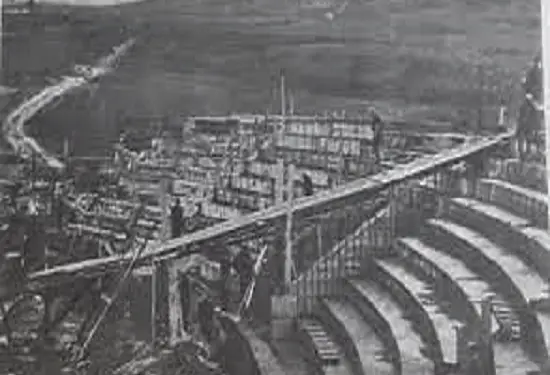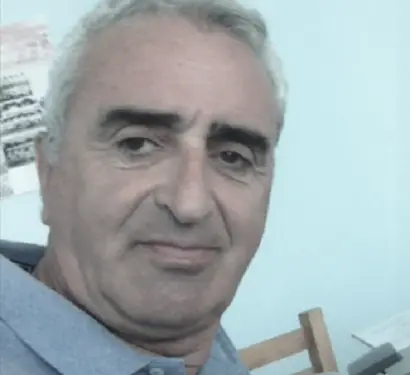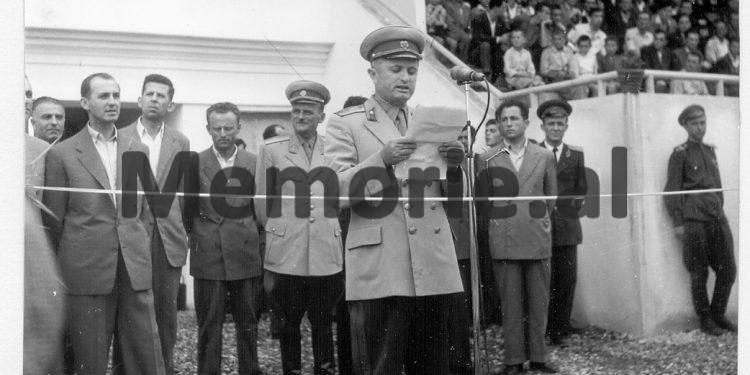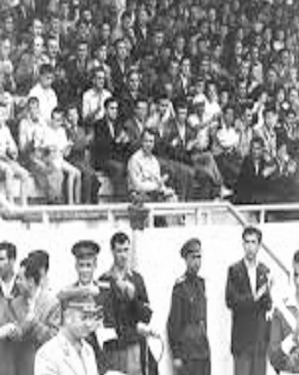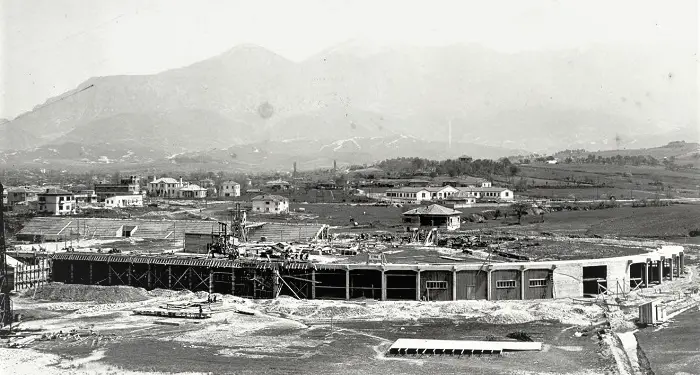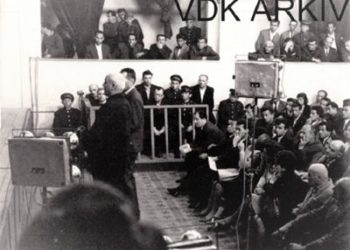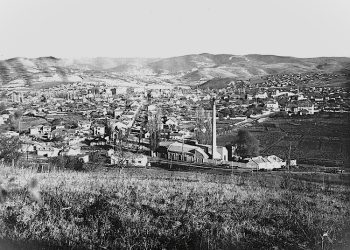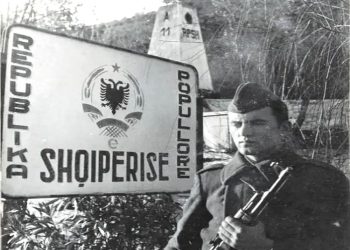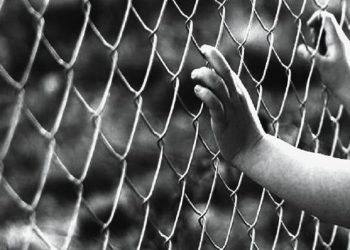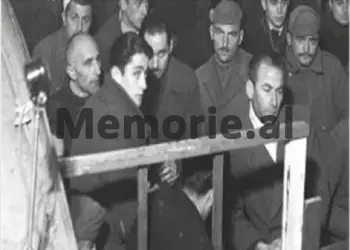From Uvil Zajmi
Memorie.al / At the end of the War and mainly after the 1945s, Albania only inherited sports grounds, such as the famous “Shallvara” in Tirana. The intensive return of sports, especially football, required the creation of suitable conditions for the development of national and international activities. The only national stadium, “Qemal Stafa”, started by the Italians and completed by the Albanians, in which the 1946 Balkan Games in football and athletics took place, and after it comes the “Vojo Kushi” of Shkodra, built in 1953.
In those environments, in addition to the football field, there were athletic tracks and in their annexes volleyball and basketball fields, where the official or friendly events of the time were played. Except for these two cities, everywhere in Albania for many years, it was played only on football fields.
Tirana, stadium also for “Dinamon”
There were several reasons why Tirana in the late 1950s was looking for a second stadium. First, as a necessity of the time for the large number of such 5-6 teams in the First Category and the large flow of matches, up to three matches in a day at the “Qemal Stafa” Stadium.
Then, friendly international meetings with clubs from Eastern European countries, which created overload for the capital’s national team. But, also as a desire of the officials of the Ministry of Internal Affairs, that their team “Dinamo” had a stadium, typical and similar to the Russian ones, was another reason for the construction of another stadium in Tirana.
Construction, free area only bush!
The terrain where it is today, in the western part of the city, was chosen as a free area at that time covered with bushes. Only a few buildings around, like the two ‘Dalia’ villas and the three four-story Aviation buildings to the north of it, built in the time of Italy for the military and aviators, but since the war, were used for foreign embassies.
In the southeast are the four Moskate’ buildings, with the same structure as those of Aviation. They are called ‘Moscate’ after the Italian architect who designed them. In the northwest there was a three-story building (it is still there today), also from the time of Italy, which served as a public house for them, while later, as a ‘Children’s Home’, a 7-year school, counseling, residential house, etc. During the years 1952-’53, the two-story buildings to the south of it were built, while those in front of the tribune, two years later.
With prisoners, some sports works
The stadium began construction in 1956 and its inauguration took place on July 8, 1959. During the 1950s-60s-70s, political prisoners were used as labor force for the construction of several large sports centers, mainly in the capital. Such is the history of the “Dinamo” stadium, built with the work of contingents convicted for various criminal offenses.
Only with one shift, from 08:00 to 16:00, in a fenced area and under the control of soldiers, who stood in the high towers erected around the area. It has been worked intensively. In such conditions, the “Dinamo” complex was built with the forces of prisoners in 1986. While the Ministry of National Defense, for the construction of the complex, annexes and facilities of the “Partizani” Sport Club, used soldiers as a labor force, in the construction of maintenance of sports grounds.
Stadium and club, Olympic environment for the time
“Dinamo” was designed as an open stadium, with Olympic parameters for the time, with a ring and no more than 12 steps, with a capacity of 12,000 thousand seats. With a covered and structured stand with stairs for the teams to climb up to receive the trophy, as well as two sectors called “annexes” on the wings of stands A and B. With 7 entrances and exits for fans, two on each side sector, one in front and two in the central stand, along with the main entrance for referees, footballers, officials, etc.
Two dressing rooms located under the A stand, from where the exit of the football players to the field was also carried out, but since the 90s it has been done under the VIP stand. Next to the stadium, in the north-western part, a training field was built for the team (it is still there today). Ticket prices ranged from 30 ALL for the grandstand, 20 ALL for the annex and the one in front, and 10 ALL for the side tickets that were sold at a point in front of the ‘Aviation Buildings’.
A large scoreboard and 45-minute clock on the south side, as well as greenery around its infield. For the time it performed two functions: stadium and Sports Club where the administration was located. From the first chief or director such as T. Golemi, R. Avdia, V. Afezollli, P. Arbana, C. Hysi, to the chief accountant E. Topi, to the field maintainers Sh. Luke of A. Baruti.
Not forgetting Gëzim the cook with his assistants Fadilen, Leko, but also Fatusha of the laundry, shoemakers I. Keçi and R. Agolli, and drivers L. Gjikuria, who was also a football player together with Q. Toto. Unlike that of “Qemal Stafa” with 6 lanes, the track of “Dinamo” had 8 such, although not with tartan, but with and black. The opposite of the field, the bigger one of “Qemal Stafa”, compared to “Dinamo”, smaller in size, so much so that for the capital’s teams, it was said that they had difficulty playing and winning, when the opponents gathered in the area.
What sporting events are associated with the “Dinamo” stadium?
There are several big and important sports events for the time related to the “Dinamo” stadium. Two memorable matches for the championship title were played there in July 1961, “Partizani”-“Dinamo”. 1-1 the first match with the goals of Refik Resme and Stavri Lubonja, then the second challenge after four days with the historic goal of Panajot Panos from the southern gate, in the third overtime of the match, exactly in the 122nd minute.
Even the confrontation with more spectators, even above the allowed capacity, as was “Partizani” – “Fenerbahce” on September 30, 1961 for the Balkan Cup, when the fans burst the gates. In this stadium, on February 26, 1961, during the “November 17”-“Besa” match, the Kavaja goalkeeper, Shefqet Topi, made the most spectacular, very rare historic reception for national football, winning the sports photo contest organized in Moscow.
Exactly, in this stadium, Panajot Pano played with the shirt of “Dinamo” in the Balkan Cup in 1962, a unique occasion for the legend of “Partizani”. On the morning of February 16, 1971, the great (West) Germany of Gert Müller, Franc Beckenbauer, Netzer, Overat and Majer, the day before the match, held a training session in this very stadium overflowing with fans, fans and all the people of Tirana.
But, in this stadium, the national team of Albania has not held any official meeting during its history. The stadium has served for training and matches of “Shpresa” teams, clubs in international activities, mainly in the Balkan Cup, or for all official activities organized by the Albanian Football Federation, cups, various trophies, spartakiades, etc. Many athletic competitions have been held there, records have been broken over the years. Until the day the works began, it was the only stadium without lighting in Albania.
Rare, maternity next to him…!
It may be the only one that has had a maternity hospital nearby, like no other stadium in the world! Every call for a goal, or a cheer, has been very close to a newborn child, and many of that generation even associate the date of birth with a sporting event in that stadium.
Next to the front stand, a previously deserted area, then a market in the 1970s, where bananas were first traded, exactly in that place in the mid-1970s and 1980s was designed and built built the second Maternity Hospital in Tirana, after the one in “Treni”. It has been operating as such for many years, while it changed destination only a short time ago.
From rallies, to “rock & roll”, “Scorpions”!
Never before, but only after the 90s, the concept changed that in a football stadium, giant concerts of singers, as well as well-known light music or “rock” groups can be given, although over the years and in different periods , mass demonstrations, sports spartakiades, etc. have been organized.
The first ‘historical’ recital concert given by an artist, even a foreigner in Albania, was that of the Italian singers, Albano and Romina Pauer, at the “Qemal Stafa” Stadium, on an improvised stage in the field. While in “Selman Stërmasi”, he met the well-known German group “Scorpions”, to give a magnificent concert. Then endless rallies of political parties.
Change, structure is preserved
For many decades that stadium has been the “property” of “Dinamo”, but in the 1990s, it was known as “Selman Stërmasi”, in honor of the first president and one of the founders of the club, a great personality of Albanian football. (before and after the War) especially the “17 November” Club, “SK Tirana”. The stadium has not been working for years, as it had begun to depreciate completely.
With the modern project, the traditional structure has been preserved, with a capacity of 9,600 seats; the dimensions of the field have changed, being enlarged to a dimension of 116 × 74 m, while the athletics track will no longer exist. While the field itself, where it will be played entirely with natural grass, will be 105×68 m, in FIFA dimensions. Likewise, the lighting, as part of the stadium, will be functional and modern. It does not change the tribune, which remains as the only covered part of it.
Inside, there will be halls, such as catering, press, journalists’ quarters, radio and television broadcast rooms, and the stadium is designed as multifunctional, being also a sports club with administration offices, a trophy room, etc.
Medi Bushati: “There I met my wife, Vera”
“It was conceived as a modern stadium for the time and the idea for its construction was mainly to serve the club “Dinamo” and its athletes, – says Mehdi Bushati, former footballer of the National Team and “Dinamo”. – The purpose was also for the development of national championship matches, friendly tournaments, international activities, as there were many, mainly with clubs.
It was designed by well-known architects and engineers with a double function as a stadium and a club, with two floors in its central part, where “Dinamo” athletes would train, holds matches, but also is accommodated while living there. On the first floor I remember there was a canteen, laundry, club administration offices, dressing rooms, while on the second floor, the sleeping quarters for the players, mainly those coming from different cities.
Not only football players, but also for elite athletes from other sports, such as the talented athlete Lutfi Guri, who together with Iljaz Çeço, the three of us slept in the same room during the years of the faculty. Very soon the stadium was transformed into an active sports environment, as other competitions were held there, such as athletics, weightlifting, wrestling, basketball, volleyball, etc., and there was even a strength gym nearby.
In that stadium, along with my sports career, I also have an important memory for my life: it was on its track that I met my wife, Vera…”, Bushati recounts with nostalgia.
Stavri Lubonja: The inauguration, I was on the field that day
Football player of “Dinamos”, of the National Team and absolute protagonist with “Dinamos” of the 60s, Stavri Lubonja, looks back on the inauguration day and remembers: “I was present on the day when it was inaugurated, and I even have the photos of that moment. The speech was given by Major General Xhule Çiraku and in the presence of many curious spectators and near the referees M. Tiko, I. Cani, B. Qorri and Xh. Shaqiri’s ribbon was cut by Ramiz Alia. Then, there was a meeting between two Dynamo teams, in which I was on the pitch.
Meanwhile, on July 10, the friendly match “Partizani”-“Forverst” of East Germany was played, as two military teams of the Ministry of Defense. I remember that the referee was Shasivar Gruda, with his assistants, Godari and Hysenaj. The match ended 1-1, with a goal from Kolec Kraja, in the southern gate, after an individual action, which equalized in the last seconds.
My whole career connects me with that stadium. I played there, I trained, I slept, but also the most unforgettable moment: I scored the equalizing goal in the first final “Partizani”-“Dinamo” 1-1, in 1961″, remembers Lubonja with a lot of nostalgia. Memorie.al




